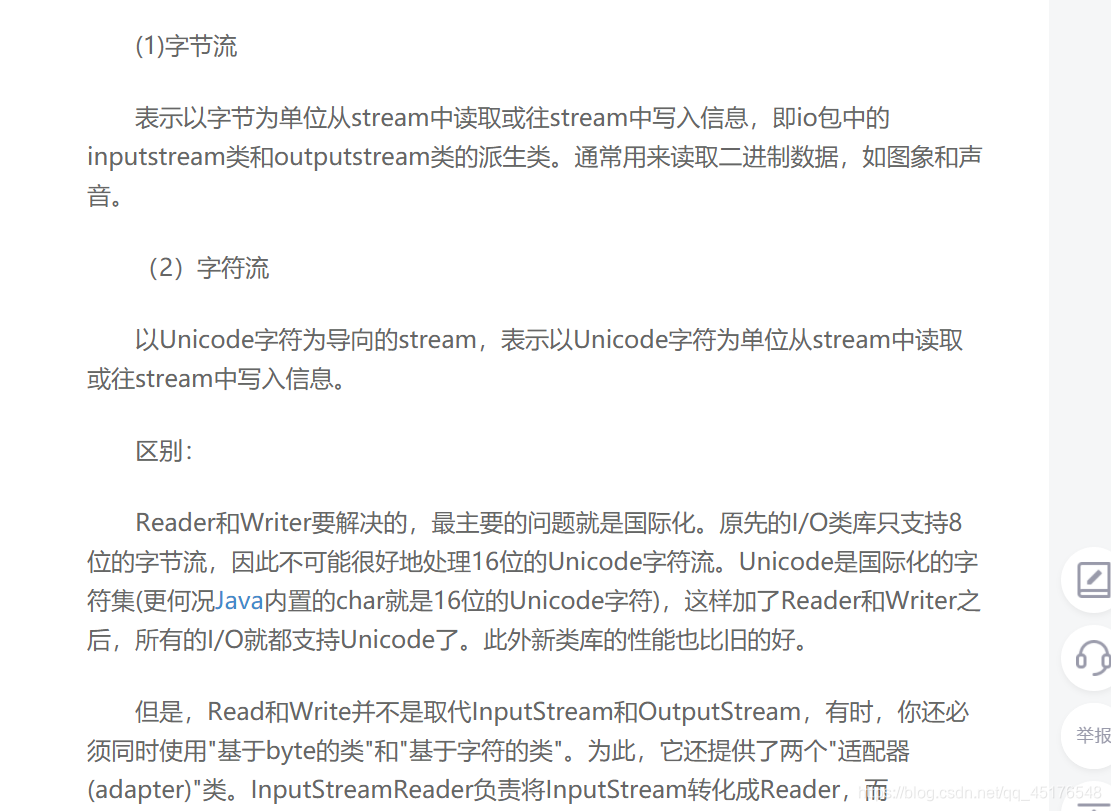实验目的:
1.理解I/O流的概念,掌握其分类。
2.掌握文本文件读写、二进制文件读写。
实验内容:
1.编程实现任意文件的复制功能。
2.利用文件流和缓冲流复制文件的内容。
3.创建文件和显示文件的名称和内容。
4.接收键盘输入的字符串并显示在屏幕上。
实验步骤:
1.编写一个程序将字符串“明月松间照,清泉石上流。”写入C:\a.txt中,并实现对该文件的读取。
源代码:
package homework.实验9_输入输出流;
import java.io.BufferedWriter;
import java.io.FileWriter;
import java.io.IOException;
import java.util.Scanner;
public class sy9_1 {
public static void main(String [] args){
Scanner sc=new Scanner(System.in);
String s=sc.nextLine();
System.out.println("写入字符串 : "+s);
try {
BufferedWriter bw=new BufferedWriter(new FileWriter("d:\\a.txt"));
bw.write(s);
bw.flush();
bw.close(); //关闭流
} catch (IOException e) {
e.printStackTrace();
}
}
}
运行结果截图:

2. 编写一个程序利用字节流将C:\a.txt中的内容复制到另一个文件b.txt中,并提示“文件复制成功。”。
源代码:
package homework.实验9_输入输出流;
import java.io.*;
public class sy9_2{
public static void main(String[] args)throws IOException{
FileInputStream read = new FileInputStream(new File("D:\\a.txt"));
FileOutputStream wr = new FileOutputStream(new File("D:\\b.txt"));
byte[] b = new byte[1024];
int len = 0;
while((len=read.read(b))!=-1){
wr.write(b,0,len);
wr.flush();
}
wr.close();
read.close();
}
}
运行结果截图:

3. 编写一个程序利用字符流将C:\a.txt中的内容复制到另一个文件b.txt中
源代码:
package homework.实验9_输入输出流;
import java.io.FileNotFoundException;
import java.io.FileReader;
import java.io.FileWriter;
import java.io.IOException;
public class sy9_2 {
public static void main(String[] args) {
// TODO Auto-generated method stub
FileReader fr = null;
FileWriter fw = null;
int c = 0;
try {
fr = new FileReader("d://a.txt");
fw = new FileWriter("d://c.txt");
while((c=fr.read())!=-1) {
fw.write(c);
}
System.out.println("文件复制成功");
}catch(FileNotFoundException e) {
System.out.println("文件没找到");
}catch(IOException e) {
System.out.println("输入错误");
}finally {
try {
fw.close();
} catch (IOException e) {
// TODO Auto-generated catch block
e.printStackTrace();
}
try {
fr.close();
} catch (IOException e) {
// TODO Auto-generated catch block
e.printStackTrace();
}
}
}
}
4.以下程序实现对象序列化和反序列化,请把程序补充完整。
Student 类:
import java.io.Serializable;
public class Student implements Serializable{
private String name;
private int age;
private String address;
public String getName() {
return name ;
}
public void setName(String name) {
this.name = name;
}
public int getAge() {
return age ;
}
public void setAge(int age) {
this.age = age;
}
public String getAddress() {
return address ;
}
public void setAddress(String address) {
this.address = address;
}
}
测试类:
import java.io.*;
public class Test {
public static void main(String[] args) throws FileNotFoundException, IOException, ClassNotFoundException {
Student mStudent1 =new Student();
mStudent1.setName ("张三");
mStudent1.setAge(18);
mStudent1.setAddress("武汉市");
//ObjectOutputStream代表对象输出流,它的writeObject(Object obj)方法可对参数指定的obj对象进行序列化,
//把得到的字节序列写到一个目标输出流中,在这里写到文件输出流。
ObjectOutputStream oos = new ObjectOutputStream(new FileOutputStream("D:/Student.txt"));
oos.writeObject( mStudents1 );
oos.close();
System.out.println("序列化完成");
//ObjectInputStream代表对象输入流,它的readObject()方法从一个源输入流中读取字节序列,
//再把它们反序列化为一个对象,并将其返回。
ObjectInputStream ois = new ObjectInputStream(new FileInputStream("D:/Student.txt"));
Student mStudent2 = ( Student ) ois.readObject();
ois.close(); System.out.println(mStudent2.getName()+"\t"+mStudent2.getAge()+"\t"+mStudent2.getAddress());
}
}
实验小结
通过数据流、序列化和文件系统提供系统输入和输出。Java把这些不同来源和目标的数据都统一抽象为数据流。Java语言的输入输出功能是十分强大而灵活的,美中不足的是看上去输入输出的代码并不是很简洁,因为你往往需要包装许多不同的对象。

- 序列化和反序列化概念
把对象转换为字节序列的过程称为对象的序列化。
把字节序列恢复为对象的过程称为对象的反序列化
对象的序列化主要有两种用途:
1) 把对象的字节序列永久地保存到硬盘上,通常存放在一个文件中;
2) 在网络上传送对象的字节序列。